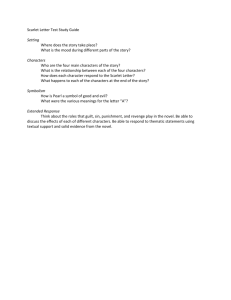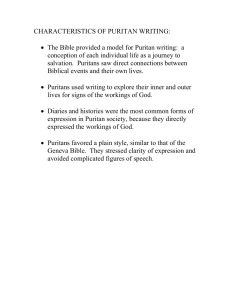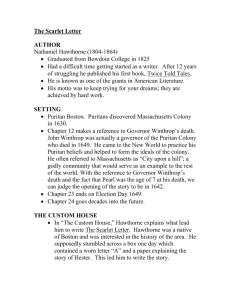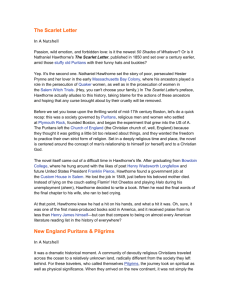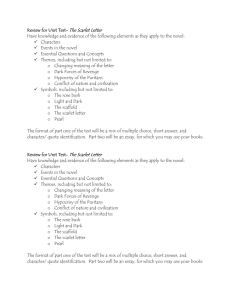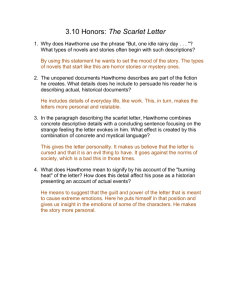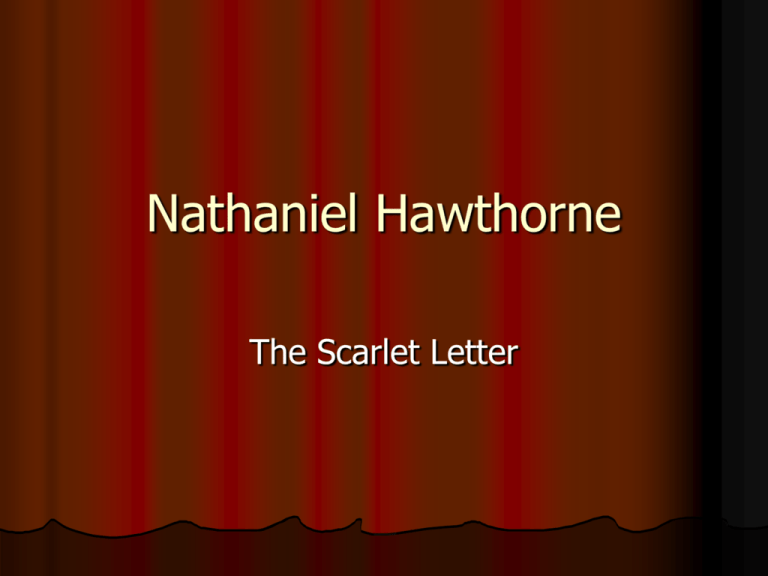
Nathaniel Hawthorne
The Scarlet Letter
Puritanism/Scarlet Letter Timeline
In History:
1620-1628 -Pilgrims/Puritans come
to America
-Harvard founded-religious
1638
higher education
1642
1645
1649
1655
1692
-Christmas Celebration
outlawed by Puritans
-Salem Witch Trials: dissent, love
1850
triangles, landlust=breakdown of Puritan
theocracy ; w/Judge John Hathorne
In the novel:
-Ch. 1-4 public scaffold scene
Pearl=baby in mother’s
arms
-Scene at Governor
Bellingham’s
Pearl=3 years old
-Novel’s climax at scaffold
Pearl=7 years old
-Last Chapter of novel (sort of)
Hawthorne publishes Scarlet Letter (200 years later, during Romantic
Era, so written in romantic style, but with Puritan influences and themes)
Hawthorne Bio Info
1804-Childhood
College 1821-1825
Isolation 1825-1837
1837
1839
1842
1846-1849
1850
1851
1852
1853-1860
1860
1863
1864
=
=
=
=
=
=
=
=
=
=
=
=
=
=
Salem: born, father dies, family poor, single mom, adds w
Bowdoin, Maine w/F. Pierce, goofed off, mediocre student
“dismal chamber” to learn how to write well
Twice Told Tales, about secrets of violence in heart
Engaged; utopian farm-Brook Farm w/Transcendentalists
Marries Sophia, moves to Concord where famous writers
job at Custom House; mom dies, loses job
Scarlet Letter $ and success “hellfire story”
House of Seven Gables and Snow Image
Blithedale Romance
U.S. Counsel at Liverpool, Marble Faun—travel log
Pierce defeated; Lincoln=Civil War, H. out of place
journals Our Old Home
dies (of solitude, according to Emerson)
HISTORICAL CONTEXT
To what “period” of American
Literature does Hawthorne belong??
Lets take a look at the history of
American Literature…..
HISTORICAL CONTEXT
English Heritage (Elizabethan Age)
1570-1650: Early Colonial periodPuritan writings, no distinctive American
literature
1750-1800: Later Colonial periodAge of Reason/Enlightenment
(Neoclassicism, Rationalism)
HISTORICAL CONTEXT
1800-1850: American Renaissance/
Romanticism- slave narratives, inner
feelings, the burden of a Puritan past, the
rejection of Neoclassicism
Transcendentalism was a part of this…
American Romanticism
Authors: Washington Irving, Edgar Allen Poe (more
Gothic/Dark Romantic), Hawthorne
Contemporary with Transcendentalists—
Emerson and Thoreau
Valued feelings and intuition over reason
Reaction against classicism (rationalism)
Valued individual freedom and worth of individual
Explore subconscious; pre-Freudian psychology, faith in
inner experience
More individualistic, less societal; about finding yourself
Seems ancient, traditional, gothic, pastoral
Role of Frontier, critical of society—escape to nature to
gain moral and spiritual development
Gothic elements (darkness, considers conflicts between
good and evil, sin, insanity, psychological effects, etc.)
Power of imagination
Beauty in exotic, supernatural, myth/legend/folklore
HISTORICAL CONTEXT
TRANSCENDENTALISM
Boston-centered movement, led by Emerson,
was an important force in New England circles
Human existence transcends the sensory realm
Belief in individual choice and consequence
Focus on the positive
HISTORICAL CONTEXT
SUBDIVISION OF ROMANTICISM: GOTHIC
LITERATURE, the “dark romantics”(1800-1850)
-use of supernatural
-motif of double (both good and evil in
characters; sin and evil does exist)
-depression, dark forests
-Poe, Hawthorne, Melville
-emphasis on symbolism (which we will discuss later)
NATHANIEL HAWTHORNE
“The Scarlet Letter is powerfully
written but my writings do not, nor
ever will, appeal to the broadest
class of sympathies, and therefore
will not obtain a very wide
popularity.”
-Hawthorne, after finishing the novel
NATHANIEL HAWTHORNE
As a literary artist…
First American “pro writer”: college
educated, familiar with the great European
writers
4,000 copies of The Scarlet Letter sold in
the first 10 days
LITERARY ELEMENTS
Characters
Mood
Setting
Plot
Symbolism
Themes
LITERARY ELEMENTS: MOOD
The SOMBER, DARK mood is welldefined from the beginning:
“sad-colored garments” of spectators, the
prison door which is “heavily timbered and
studded with iron spikes”
LITERARY ELEMENTS: SETTING
17th century Puritanical
New England (Mass.)
What was America like then?
LITERARY ELEMENTS: SETTING
Life in the Mid 1600s
Boston was founded just 2 decades earlier
1st governor was John Winthrop, who governed based on religious
and civic ideals
People were hardworking and devoted
1630s- Puritans established a number of settlements in
Massachusetts
PURITANISM involved belief that the church of England was too
much influenced by the Catholic church
Strict code, on which people were expected to act and judged upon
Rejected belief that divine authority is channeled through any one
single person (i.e. the pope)
THEOCRACY- state governed by the church
Theocracy as Extremism
Ironically, it is largely
because of the Puritans – who
themselves established a
theocratic government in the
New World – that we in
America tend to view most
theocratic governments as
extremist.
Puritanism
Began in England in the mid-1500’s
A sect of Calvinists
Calvinism named after Swiss theologian
John Calvin
Calvinism =
predetermination
no
religious authority BUT Scripture
“Puritans”
“Puritans” intended as a derogatory
term
“Puritans” usually referred to
themselves as “the Godly”
(http://en.wikipedia.org/wiki/Puritanism)
Puritans fell quickly out of favor in
England, where the king was the head
of the Church of England.
They recognized neither the king’s
secular or religious authority, and so
quickly became enemies of civil and
religious leaders.
The Puritan Role in Development of “American”
Character
In 1600, the Puritans left England for
Holland, which even in the 17th century
was a very liberal society.
It was too liberal for the Puritans, though,
who disliked the government’s
permissiveness and tolerance of
behaviors/attitudes they found
unacceptable.
The Puritan Role in Development of “American”
Character, cont.
In 1620, the Puritans left Holland for the
New World.
Established Plymouth Plantation in the
“savage wilderness” of New England.
Retained those aspects of European
society they liked; created new laws,
policies, etc. to replace the elements of
society they did not like.
The Puritan Role in Development of
“American” Character, cont.
Because Scripture was central to religion
and government, scholarship was a highly
valued right (reserved, of course, to men
only).
The role of religious leaders was to
present Scripture and guide other church
members in its understanding and
application.
Puritan religious leaders were NEVER seen
as intermediaries or intercessors.
The Puritan Role in
Development of
“American” Character, cont.
“Puritan leaders were highly trained
scholars, whose education tended to
translate into positions that were often
authoritarian.”
http://xroads.virginia.edu/~CAP/PURITAN/purhist.html
“There was a built-in hierarchism in this
sense, but one which mostly reflected the
age.” http://xroads.virginia.edu/~CAP/PURITAN/purhist.html
Very Important: Anybody (theoretically)
could rise to the same level of authority.
So…
The Puritan emphasis on:
self-reliance
independence
individual achievement
individual responsibility
personal accountability
power through ability
(education)
• All of which were
discouraged in the
Old World become
the basis of
“American Rugged
Individualism”
• This is probably why
most Americans
disagree so strongly
with theocracies
Puritan “Crime and Punishment”
Because Puritan Boston c. 1690 was still a
theocratic society, crime against church (or God)
was the equivalent of a crime against another
person or against “the State.”
Yes… it was illegal to miss church on Sabbath
days. It was also illegal to sleep during sermons
that could run 3 or more hours long – during each
session (morning and afternoon) on a Sabbath.
http://www.materialreligion.org/objects/dec96obj.html
Puritan “Crime and
Punishment”, cont.
The
Stocks
http://etc.usf.edu/clipart/2100/2111/pillory_1_md.gif
Virtually any offense could land you
in the pillory, or stocks. The Puritans
imported this punishment to New
England from England.
Entire purpose was public display
and public humiliation.
Stocks were built on a scaffold in
the center of the village, where
townspeople could mock the
offender, and throw rotten
vegetables or stones. Aside from the
offender’s hands being immobilized,
his ears would frequently be nailed
to the board behind his head.
Puritan “Crime and
Punishment”, cont.
After serving time in a jail and
then on the pillory, a convicted
criminal would often be required
to wear some outward sign of his
or her offense.
In 1637, as punishment for
writing an essay that criticized
the archbishop, William Prynne
(no relation to the central
character in The Scarlet
Letter) – after being put in the
stocks – had the letters “SL” (for
“seditious libeler”) branded onto
his cheeks.
http://history.wisc.edu/sommerville/367/367-06.htm
LITERARY ELEMENTS: SETTING
What aspects of this type of religious society can
be seen in The Scarlet Letter?
How do you think Hawthorne views this type of
society?
How did his life affect the
writing of the novel?
1. Influences on Hawthorne: Puritan background
John Hathorne presided over
the Salem Witch Trials of
1692
Major William Hathorne (16081681) persecuted quakers
MAJOR THEMES
PURITAN MORALITY v. PASSION AND INDIVIDUALISM
/Adultery
Individual Rights/Self-trust v. accommodation to
authority
Conventional v. unconventional gender roles
Guilt: sense of guilt forced by puritanical heritage/society
Hypocrisy v. Integrity
Moral Pride v. Intellect
The penalties of isolation/ isolation because of self-cause
and societal cause
Patriarchal power
Belief in fate/free will
Impossibility of earthly perfection
MAJOR THEMES
Perhaps his greatest interest was the human capacity on
how sin operates on the inner workings of minds
With the superstition common to his
brotherhood, he fancied himself given
over to a fiend, to be tortured with
frightful dreams, and desperate
thoughts, the sting of remorse, and
despair of pardon; as a foretaste of
what awaits him beyond the grave.
But it was the constant shadow of my
presence!--the closest propinquity of the
man whom he had most vilely
wronged!--and who had grown to exist
only by this perpetual poison of the
direst revenge! Yea, indeed!--he did
not err!--there was a fiend at his elbow!
A mortal man, with once a human
heart, has become a fiend for his
especial torment!" The unfortunate
physician, while uttering these words,
lifted his hands with a look of horror, as
if he had beheld some frightful
shape, which he could not
recognize, usurping the place of his
own image in a glass.
“smile with a sinister meaning”
How did his life affect the
writing of the novel?
2) Salem- childhood, later work at the Custom
House, as Surveyor of the Port
“The Custom House” introduction creates a
FRAME STORY
This introduction gives an account of his experience as
surveyor; he attacks the officials who connived in his
dismissal… Like his heroine Hester, Hawthorne emerges
from confrontation with a self-righteous society as an
individual of integrity,passion, and moral superiority.
SYMBOLISM
Symbolism is evident in the following
objects in The Scarlet Letter.
What implications are made through the use
of these symbols?
Symbols
Rose/rosebush
Letter A
Light/Dark
Pearl
The Leech
Others
LITERARY ELEMENT:
SYMBOLISM IN THE NOVEL
SYMBOLISM
The A!
“It was so artistically done, and with so much
fertility and gorgeous luxuriance of fancy, that it
had all the effect of a last and fitting decoration
to the apparel which she wore; and which was
of a splendor in accordance with the taste of the
age, but greatly beyond what was allowed by
the sumptuary regulations of the colony.”
“Not a stitch in that embroidered letter, but she
has felt it in her heart.”
SYMBOLISM
Hester’s and Pearl’s Clothing
“Her own dress was of the coarsest materials and
the most sombre hue; with only that one
ornament—the scarlet letter—which it was
her doom to wear.”
“The child’s attire, on the other hand, was
distinguished by a fanciful, or, we might rather
say, a fantastic ingenuity, which served,
indeed, to heighten the airy charm that early
began to develop itself in the little girl…”
SYMBOLISM
PEARL (the name)
“Her Pearl!—For so had Hester called her;
not as a name expressive of her aspect,
which had nothing of the calm, white,
unimpassioned lustre that would be
indicated by the comparison. But she
named the infant “Pearl,” as being of
great price—purchased with all she
had—her mother’s only treasure!”
SYMBOLISM
The Leech
“He gathered herbs here and there”
“The Custom House” General Info.
Custom House: Government building where customs
are collected and where ships are cleared to enter or
leave county (by water)
Hawthorne worked there for 27 months 1847-49 as
surveyor (pretty much everyone else’s boss)
“The Custom House” is both factual and fictional—he
did work at one and tells stories of real people, but
made up some of the stories, esp. the Letter A and
Hester Prynne
“The Custom House” is intro. to Scarlet Letter—
included for $ and more text, but also to set up
explanation why he wrote it (fictional) and themes of
isolation, alienation, etc.
Custom House Picture
From first page of "The Custom-House" chapter in the
1878 edition of The Scarlet Letter published in 1878 by
James R. Osgood and Co. in Boston.
“The Custom House” and The Scarlet Letter
The introductory chapter to The Scarlet Letter is called “The Custom
House”.
Nathaniel Hawthorne tells of his time as a clerk in the Salem, Mass.
Government Custom House.
He claims to have found a letter written by Hester Prynne (the novel’s
main character) and an embroidered scarlet A. The letter tells of
Hester’s experiences, which Hawthorne relates in the novel.
The novel is NOT based in historical fact, but Hawthorne uses “The
Custom House” to give his story credibility.
Hawthorne’s family came from Boston. He was descendant of a judge
in the Salem witch trials (named Hathorne). Hawthorne changed the
spelling of his name to distance himself from his relative’s unsavory
reputation.
http://www.hawthorneinsalem.org/Life&Times/BiographicalInfo
/Adultlife/MMD1114.html
THE END

